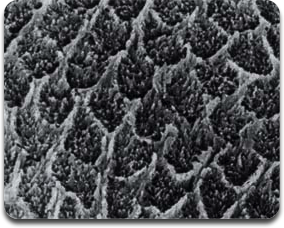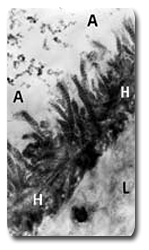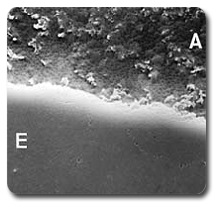In 1978, Prof. T. Fusayama from the Tokyo Medical and Dental University was confronted with a technical problem. He had the idea of permanently filling cavities with resin materials as an esthetic alternative to amalgamate. But in contrast to hydrophilic tooth hard structure, the composites displayed hydrophobic properties and were not capable of establishing a close bond. To get around this problem, he developed a new technique for the conditioning of the dentin which would provide a surface suitable for the use of an adhesive. Going against the philosophy of the times, he etched both enamel and dentin with phosphoric acid (H3PO4). This preparation of the dentin removed the smear layer which appeared after the preparation, opened the dentin tubuli, and created the conditions for use of the following primer-adhesive system. In cooperation with the company Kuraray – at that time an industrial manufacturer of innovative special resin materials – the first total-etch bonding including an adhesive phosphate monomer for enamel and dentin, CLEARFIL BOND SYSTEM F, was developed at this time.While this system rapidly gained acceptance in Japan, the dentin phosphoric acid etching was the subject of controversial discussions at the international level for a long time. It was not until the middle of the 1980s that it gained worldwide acceptance and has since been one of the standard procedures for multi-step adhesives. The advantages of this technique are self-evident and have been confirmed over the course of time by numerous scientific studies: Besides the removal of the smear layer, there is a demineralization of the intertubular and peritubular dentin. Hydroxyapatite crystals from the collagen network are released and individual fibers are exposed. They are then coated by the hydrophilic monomers of the adhesive and permanently anchor themselves in the exposed network during the polymerization.
 Increased technique sensitivity of the total-etch system led to development of the self-etching technique. Although these systems produce good results when used correctly, total-etch multi step adhesives were regarded as highly technique-sensitive in Japan due to the precision required for the work steps and times: excessive etching removed more minerals from the dentin than desired and exposed the collagen fibers to a depth which was greater than the following adhesive could penetrate. Excessive drying caused the exposed collagen fiber network to collapse and blocked the access of the adhesive to the dentin areas below. This led to lower adhesive strength and simultaneously sensitivities and biting down pain. The selection of the volatile solvent in the bonding systems also influenced the moisture of the dentin surface required for ideal results: Since alcohol is lighter than water, alcohol-based systems require an extremely dry surface, which means that there is a high risk of overdrying.
Increased technique sensitivity of the total-etch system led to development of the self-etching technique. Although these systems produce good results when used correctly, total-etch multi step adhesives were regarded as highly technique-sensitive in Japan due to the precision required for the work steps and times: excessive etching removed more minerals from the dentin than desired and exposed the collagen fibers to a depth which was greater than the following adhesive could penetrate. Excessive drying caused the exposed collagen fiber network to collapse and blocked the access of the adhesive to the dentin areas below. This led to lower adhesive strength and simultaneously sensitivities and biting down pain. The selection of the volatile solvent in the bonding systems also influenced the moisture of the dentin surface required for ideal results: Since alcohol is lighter than water, alcohol-based systems require an extremely dry surface, which means that there is a high risk of overdrying.
Acetone-based adhesives, on the other hand, work best on a slightly moist surface because acetone is drawn into the tubuli through a moist surface. But since the definition of “slightly moist” is difficult to realize during actual work, the bonding results are worsened if the surface is either too dry or too moist.
 “CLEARFIL LINER BOND 2” was introduced by Kuraray at the beginning of the 1990s as the first self-etching adhesive in the world. The objective was to eliminate the technique sensitivities caused by the total-etch technique and to develop a system which required fewer work steps, achieved permanently reproducible results, and at the same time could prevent sensitivities and biting down pain for the patient. A water-based, self-etching primer was developed to avoid problems related to a separate etching technique or a defined surface moisture. This primer conditioned enamel and dentin in much the same way as phosphoric acid, but was not as aggressive and could be buffered in its effect by released calcium. The slightly acidic pH value was thus reduced further and dropped to a neutral level, which allowed the primer to stay in the cavity. This made it possible to avoid complicated work steps such as rinsing, drying, changing cotton rolls as well as the risks of excessive etching and overdrying. The following adhesive without any volatile solvents could now penetrate all of the dentin layers, closing the dentin tubuli and contributing after the polymerization to prevention of post-operative sensitivities. The development of the MDP adhesive monomer has improved further the chemical bond properties of the self-etching Kuraray adhesive. The TEM images show that the collagen fibrils in the thin hybrid layers have not completely lost the hydroxyapatite, in contrast to the total-etch technique. The remaining hydroxyapatite can directly bond chemically with phosphate groups of Kuraray’s own MDP monomer.
“CLEARFIL LINER BOND 2” was introduced by Kuraray at the beginning of the 1990s as the first self-etching adhesive in the world. The objective was to eliminate the technique sensitivities caused by the total-etch technique and to develop a system which required fewer work steps, achieved permanently reproducible results, and at the same time could prevent sensitivities and biting down pain for the patient. A water-based, self-etching primer was developed to avoid problems related to a separate etching technique or a defined surface moisture. This primer conditioned enamel and dentin in much the same way as phosphoric acid, but was not as aggressive and could be buffered in its effect by released calcium. The slightly acidic pH value was thus reduced further and dropped to a neutral level, which allowed the primer to stay in the cavity. This made it possible to avoid complicated work steps such as rinsing, drying, changing cotton rolls as well as the risks of excessive etching and overdrying. The following adhesive without any volatile solvents could now penetrate all of the dentin layers, closing the dentin tubuli and contributing after the polymerization to prevention of post-operative sensitivities. The development of the MDP adhesive monomer has improved further the chemical bond properties of the self-etching Kuraray adhesive. The TEM images show that the collagen fibrils in the thin hybrid layers have not completely lost the hydroxyapatite, in contrast to the total-etch technique. The remaining hydroxyapatite can directly bond chemically with phosphate groups of Kuraray’s own MDP monomer.
A similar effect can also be observed in the enamel. Although the enamel structure is only slightly affected, no fissure formation is determined between the adhesive, composite, and enamel. Although the adhesive strength without prior enamel etching was questioned when this technique was first introduced, various studies worldwide have since proven the equality of the MDP-based self-etching systems [average 35 MPa μTBS micro tensile bond strength; Inoue, van Meerbeek]. Data from a clinical study of n=94 restorations laid with CLEARFIL SE BOND of Class V show an adhesive bond which is 100% intact after 36 months (University of Leuven, Belgium).
 Due to the company’s lead in research in the field of adhesive and resin technology, Kuraray Dental products achieve outstanding rankings in clinical in-vivo and in-vitro examinations. “REALITY”, an independent American test institute, certified that CLEARFIL SE BOND caused absolutely no post-operative complaints (Issue 118, February 2000), while another institute praised the all-in-one adhesive CLEARFIL S³ BOND as the best in its class from a total of four all-in-one systems which were tested.
Due to the company’s lead in research in the field of adhesive and resin technology, Kuraray Dental products achieve outstanding rankings in clinical in-vivo and in-vitro examinations. “REALITY”, an independent American test institute, certified that CLEARFIL SE BOND caused absolutely no post-operative complaints (Issue 118, February 2000), while another institute praised the all-in-one adhesive CLEARFIL S³ BOND as the best in its class from a total of four all-in-one systems which were tested.